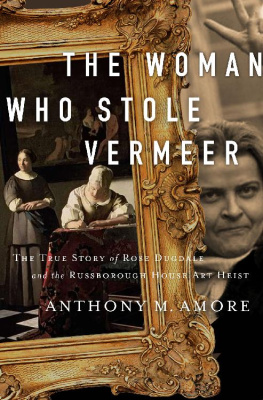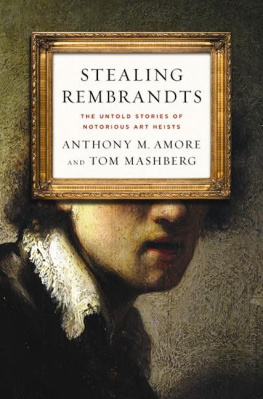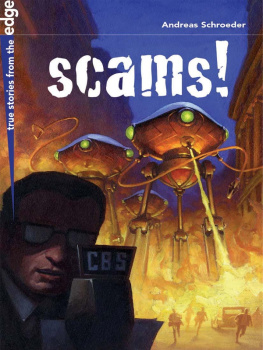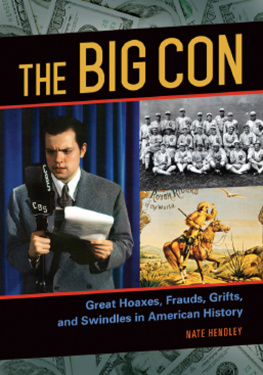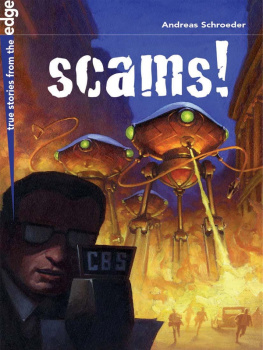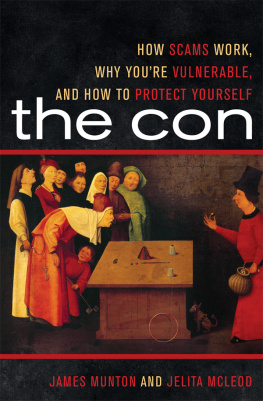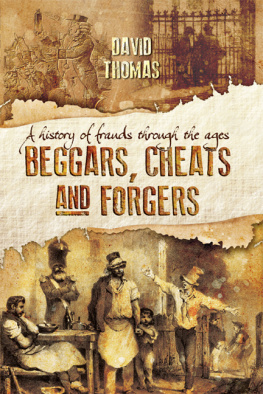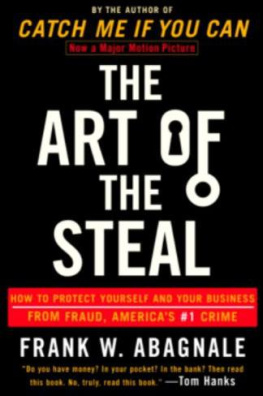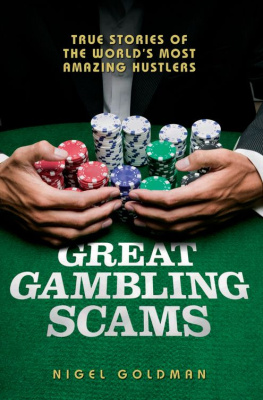
The Art of the Con
The Most Notorious Fakes, Frauds, and Forgeries in the Art World
Anthony M. Amore

The author and publisher have provided this e-book to you for your personal use only. You may not make this e-book publicly available in any way. Copyright infringement is against the law. If you believe the copy of this e-book you are reading infringes on the authors copyright, please notify the publisher at: us.macmillanusa.com/piracy .
Contents
For Gabriela and Alessandra
My life, my sweetness, and my hope
Introduction
Gilbert Stuarts iconic portrait of George Washington is likely one of the most-often-viewed images in the world. Painted in 1796 and often referred to as the Athenaeum portrait, the unfinished rendering of the newly constituted republics first president has been featured on the American one-dollar bill for more than a hundred years. The painting is shared by the National Portrait Gallery in Washington and the Museum of Fine Arts in Boston, with each institution having the honor of displaying it at three-year intervals. Its an eye-catching work and a true national treasure.
The painting certainly caught the attention and imagination of Captain John E. Swords, a merchant seaman from the Southwark neighborhood of Philadelphia. On March 1, 1801, Captain Swords approached Stuart, asking to buy a copy of the painting of the beloved Washington, who had died little more than a year before. Though he struggled with debt for much of his life, Stuart was only willing to sell provided the captain would agree to a non-negotiable condition: Swords must not make copies of the painting.
It was an understandable demand. Washington was still very much in the hearts of the nation he helped found, and selling his highly regarded portraits of esteemed Americans was how Stuart supported himself and his family. Captain Swords easily agreed to the demand, promising Stuart that he would not have the painting copied. Instead, he wished to buy the portrait in order to present it to a gentleman in Virginia. Taking the good captain at his word, Stuart sold him the work.
Soon thereafter, in that same year, Captain Swords boarded the Connecticut, a ship owned by Philadelphians James Barclay and George Simpson, with his George Washington in tow. However, his destination was not Virginiait was the Far East. And he brought with him no intention of keeping his word to Gilbert Stuart. Instead, upon arrival in Guangzhou (Canton), China, Captain Swords turned to the well-practiced copyists of that nation and placed his order: one hundred copies of the portrait, measuring 30 25 inches, painted in reverse on glass.
Such a betrayal wasnt completely out of character for the hardy seaman. Letters to his mother, back home in Philadelphia, told of his smuggling, and according to historian E. P. Richardson, Swordss was an age of a free-and-easy attitude toward customs regulations and other such petty legalities. So it is perhaps unsurprising that upon its return to America, the inbound foreign manifest of the Connecticut did not declare the 100 portraits of George Washington. Instead, it made mention of only one case painting, which, Richardson speculates, might have been the original painting that had been purchased from Stuart.
Captain Swords was able to easily find customers eager to procure a painting of the man who the citizenry saw as the greatest man in the world, their own American Cincinnatus, and went about selling the works. Provenance was no more an issue to the buyers than it was to the seller: they simply couldnt resist the opportunity to own a work by the man who was arguably the new nations greatest artist. Eventually, word that the captain was selling the portraits made its way to Stuart, who was, understandably, outraged. And so the artist resorted to that most American of actions in response: he took Captain Swords to court. On May 14, 1802, Stuart swore a complaint with the Circuit Court of the United States in and for the Eastern District of Pennsylvania. In it, Stuart, who was still a British subject, told the court of the guarantees he demanded and to which Captain Swords had agreed. He also laid out the scheme as he understood it, asking the court to subpoena and interrogate the captain as to the agreement, his actions with the paintings, and the extent of the breach of contract, requesting that they determine how many of them [he brought] into the United States with intention to vend or dispose of the same or some and how many of them and where they now are and in whose hand. Finally, Stuart asked the court that the said John E. Swords may, by the decree of this honorable court, be enjoined and restrained from vending or any way disposing of any of the said copies and may be ordered to deliver up all that remain unsold or otherwise so that the court might dispose of them as it saw fit. Before the day was out, the court acted on Stuarts complaint, ordering Captain Swords and any associates to desist from selling or otherwise disposing of the same copies of the Portraits and to have the remaining portraits ready for further action from the court.
Captain Swordss betrayal of Gilbert Stuart is the first major art scam in American history. While fraudulent schemes involving art of all sorts is quite a common occurrence in the United States, it is a not a uniquely American problem. Instead, tens of millions of dollars in illicit art changes hands every year around the world. And the dodgy captain was not the first to the game of producing rip-offs of others art, as the practice of misrepresenting the authorship or authenticity of an artwork is a centuries-old practice. In fact, no less than the great Michelangelo himself is said to have sculpted a sleeping cupid figure and used his artistic genius to manipulate it into appearing ancient so that he could sell it to Cardinal Riario of San Giorgio.
The innocent Cardinal Riario wanted so badly to believe that he had come upon a truly special piece, something that perhaps no one else had found, that he was easy prey for Michelangelos fake. His desire to own a true object of beauty was so great as to blind him to its authenticitymuch the same way one of Adolf Hitlers most trusted accomplices, Hermann Goering, was.
The founder of the Gestapo, the art-loving Goering was not a man to cross. Though he was suspicious of attempts by his enemies to deceive him, his eyes opened wide when he saw Johannes Vermeers Christ and the Adulteress. With only 35 or 36 known paintings attributed to the great Dutch master (scholars will probably argue over the actual number forever), a new Vermeer would be a crowning addition to his growing, awe-inspiring, and completely ill-gotten art collection. Even Hitler, himself a failed artist who at the time was building his Fhrermuseum to display the greatest art collection he could steal and loot, hadnt scored such a coup as a heretofore unknown Vermeer. It didnt matter that Christ and the Adulteress didnt look at all like the work of Vermeer. And according to Jonathan Lopezs excellent book The Man Who Made Vermeers, it also didnt matter that Goering doubted the paintings provenance, believing the painting might have come from a Jew, who would try to blackmail him later. The Reichsmarschall wanted to believe he had come upon the find of a lifetime.
Goering had to have the painting for his burgeoning collection and paid 1.65 million guildersthe equivalent of about $19 million todayfor this so-called missing Vermeer, which was, in truth, created by an unsuccessful artist named Han van Meegeren. In examining the works of Van Meegeren today, it is somewhat difficult to understand how anyone could see Vermeer in them. But it wasnt just the twisted, morphine-addicted Nazi who was fooled by the faux Vermeer. Even some experts of the day who examined Van Meegerens forgeries were convinced the paintings were by the great master painter. The opportunity to be part of the important new find seems to have clouded their judgment, a pattern that has been repeated several times throughout history.
Next page

